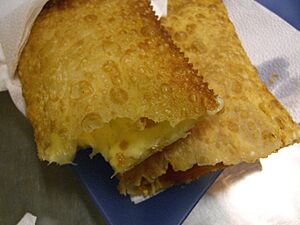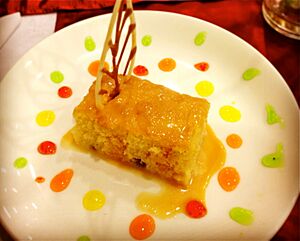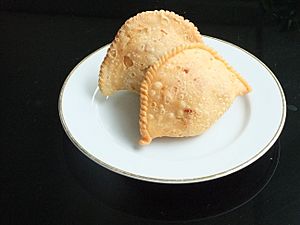Pastel (food) facts for kids
A pastel is a word from the Spanish and Portuguese languages. It usually means a pastry or a sweet, baked food. But this word can mean very different dishes in different countries. For example, in Mexico, a pastel is usually a cake. In other places, like Brazil, a pastel can be sweet or savory, depending on what's inside!
Contents
Pastel in Brazil

In Brazil, a pastel (plural: pastéis) is a popular fast-food snack. It's a thin crust pie, shaped like a half-circle or rectangle. These pies are filled with different things and then fried in hot vegetable oil. The result is a crispy, golden-brown fried pie.
Some sweet fillings for pastéis include guava paste with Minas cheese, banana, or chocolate. But pastéis can also be savory. Popular savory fillings are ground meat, mozzarella cheese, heart of palm, codfish, chicken, and small shrimp.
Pastéis are often sold on the streets or in special fast-food shops called pastelarias. A common drink to have with pastéis is caldo de cana, which is sugarcane juice. Some people believe that Brazilian Pastels were first made by Japanese immigrants. They might have changed Chinese Spring rolls to sell as snacks at street markets.
Pastel in Mexico

In Mexico, the word pastel usually means cake. A very famous example is the Pastel de tres leches. This means "three-milk cake." It's a sponge cake soaked in three kinds of milk.
This delicious cake is also eaten in other Latin American countries. These include Nicaragua, Panama, Cuba, Puerto Rico, Guatemala, and Costa Rica. However, they might use a different word for it. For instance, in Puerto Rico, the same cake is called Bizcocho de tres leches.
Pastel in Portugal
In Portugal, a pastel can be different types of desserts or appetizers. Two well-known examples are the pastel de bacalhau and the pastel de nata.
- The pastel de bacalhau is a savory fried codfish cake.
- The pastel de nata is a sweet, creamy egg custard tart. It often has a crispy, flaky crust.
Non-Sugary Pastels Around the World
The word "pastel" can also mean a starchy, non-sugary food in some Spanish-speaking countries. Sometimes, it's used in its plural form, "pasteles".
Pastel in Indonesia
In Indonesia, a pastel is a savory pie. It has a thin pastry crust filled with meat, usually chicken. It also has vegetables like chopped carrots and beans, and sometimes egg. This pie is then deep-fried. It's a popular snack sold in traditional Indonesian markets.
A similar dish from the Manado area is called panada. Instead of a thin flour crust, it uses bread. It's often filled with spicy cakalang (skipjack tuna).
Pastel in the Philippines
In the Philippines, pastel can mean a casserole dish, usually with chicken or meat, baked in a pie crust.
Among Muslim Filipinos, pastel can be spelled as pastil. This word refers to two different dishes:
- Among the Danao-speaking peoples, pastil is white rice and meat wrapped in a banana leaf.
- Among the Tausug people, pastil is a local version of the empanada, which is a savory turnover.
However, in the province of Camiguin, pastel de Camiguín is a specific type of soft, sweet bun with a filling.
Pastel in Puerto Rico
In Puerto Rico, the word is usually used in its plural form, pasteles. This is a special dish that is not a pastry at all! It includes diced pork mixed with olives, capers, raisins, chickpeas, and sweet peppers.
This mixture is placed inside a dough. The dough is mainly made from green bananas, with some plantain, yautía, and potato. The dough gets a nice color from annatto oil. Each pastel is wrapped in a plantain leaf, tied with string, and then boiled. It's often served with arroz con gandules (yellow rice with pigeon peas). This dish is quite similar to Mexican and Peruvian tamales.


